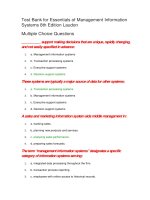Management information systems 13th laudon chapter 13
Bạn đang xem bản rút gọn của tài liệu. Xem và tải ngay bản đầy đủ của tài liệu tại đây (1.06 MB, 48 trang )
Chapter 13
Building Information
Systems
VIDEO CASES
Video Case 1: IBM: Business Process Management in a SaaS Environment
Video Case 2: IBM Helps the City of Madrid With Real-Time BPM Software
Instructional Video 1: BPM: Business Process Management Customer Story:
Besthome Store
Instructional Video 2: Workflow Management: Visualized
6.1
Copyright © 2014 Pearson Education, Inc. publishing as Prentice
Management Information Systems
Chapter 13: Building Information System
Learning Objectives
• Explain how building new systems produces
organizational change.
• Describe the core activities in the systems
development process.
• Describe the principal methodologies for modeling
and designing systems.
• Describe the alternative methods for building
information systems.
• Describe new approaches for system building in the
digital firm era.
13.2
Copyright © 2014 Pearson Education, Inc.
Management Information Systems
Chapter 13: Building Information System
New Systems and Business Processes Put MoneyGram “On the Money”
• Problem: Inefficient manual processes, legacy
systems
• Solutions: Enterprise suite to centralize data and
replace legacy software, changes to corporate
culture and organization
• Demonstrates the use of information systems to
streamline and redesign business processes
• Illustrates need to address and make changes in
culture and organization to support new systems
13.3
Copyright © 2014 Pearson Education, Inc.
Management Information Systems
Chapter 13: Building Information System
Systems as Planned Organizational Change
• Structural organizational changes enabled by IT
1. Automation
• Increases efficiency
• Replaces manual tasks
1. Rationalization of procedures
• Streamlines standard operating procedures
• Often found in programs for making continuous
quality improvements
– Total quality management (TQM)
– Six sigma
13.4
Copyright © 2014 Pearson Education, Inc.
Management Information Systems
Chapter 13: Building Information System
Systems as Planned Organizational Change
• Structural organizational changes enabled by IT
3. Business process redesign
• Analyze, simplify, and redesign business processes
• Reorganize workflow, combine steps, eliminate
repetition
4. Paradigm shifts
• Rethink nature of business
• Define new business model
• Change nature of organization
13.5
Copyright © 2014 Pearson Education, Inc.
Management Information Systems
Chapter 13: Building Information System
ORGANIZATIONAL CHANGE CARRIES RISKS AND REWARDS
The most common forms of
organizational change are
automation and rationalization.
These relatively slow-moving
and slow-changing strategies
present modest returns but little
risk. Faster and more
comprehensive change—such
as redesign and paradigm shifts
—carries high rewards but
offers substantial chances of
failure.
FIGURE 13-1
13.6
Copyright © 2014 Pearson Education, Inc.
Management Information Systems
Chapter 13: Building Information System
Systems as Planned Organizational Change
• Business process management (BPM)
– Variety of tools, methodologies to analyze, design,
optimize processes
– Used by firms to manage business process redesign
• Steps in BPM
1. Identify processes for change.
2. Analyze existing processes.
3. Design the new process.
4. Implement the new process.
5. Continuous measurement.
13.7
Copyright © 2014 Pearson Education, Inc.
Management Information Systems
Chapter 13: Building Information System
AS-IS BUSINESS PROCESS FOR PURCHASING A BOOK FROM A PHYSICAL BOOKSTORE
FIGURE 13-2
13.8
Purchasing a book from a physical bookstore requires many steps to be performed by both the seller and the
customer.
Copyright © 2014 Pearson Education, Inc.
Management Information Systems
Chapter 13: Building Information System
REDESIGNED PROCESS FOR PURCHASING A BOOK ONLINE
FIGURE 13-3
13.9
Using Internet technology makes it possible to redesign the process for purchasing a book so that it requires
fewer steps and consumes fewer resources.
Copyright © 2014 Pearson Education, Inc.
Management Information Systems
Chapter 13: Building Information System
Systems as Planned Organizational Change
• Various BPM tools used to:
– Identify and document existing processes.
• Identify inefficiencies
– Create models of improved processes.
– Capture and enforce business rules for performing,
automating processes.
– Integrate existing systems to support process
improvements.
– Verify that new processes have improved.
– Measure impact of process changes on key business
performance indicators.
13.10
Copyright © 2014 Pearson Education, Inc.
Management Information Systems
Chapter 13: Building Information System
Overview of Systems Development
• Systems development:
– Activities that go into producing an information
system solution to an organizational problem or
opportunity
1.Systems analysis
2.Systems design
3.Programming
4.Testing
5.Conversion
6.Production and maintenance
13.11
Copyright © 2014 Pearson Education, Inc.
Management Information Systems
Chapter 13: Building Information System
Interactive Session: Organizations
Burton Snowboards Speeds Ahead with Nimble Business Processes
Read the Interactive Session and discuss the following questions
• Analyze Burton using the value chain and
competitive forces models.
• Why are the business processes described in this
case such an important source of competitive
advantage for Burton?
• Explain exactly how these process improvements
enhance Burton’s operational performance and
decision making.
13.12
Copyright © 2014 Pearson Education, Inc.
Management Information Systems
Chapter 13: Building Information System
THE SYSTEMS DEVELOPMENT PROCESS
Building a system can be
broken down into six core
activities.
FIGURE 13-4
13.13
Copyright © 2014 Pearson Education, Inc.
Management Information Systems
Chapter 13: Building Information System
Overview of Systems Development
• Systems analysis
– Analysis of problem to be solved by new system
• Defining the problem and identifying causes
• Specifying solutions
– Systems proposal report identifies and examines alternative
solutions
• Identifying information requirements
– Includes feasibility study
• Is solution feasible and good investment?
• Is required technology, skill available?
13.14
Copyright © 2014 Pearson Education, Inc.
Management Information Systems
Chapter 13: Building Information System
Overview of Systems Development
• System analysis (cont.)
– Establishing information requirements
• Who needs what information, where, when,
and how
• Define objectives of new/modified system
• Detail the functions new system must perform
– Faulty requirements analysis is leading cause of
systems failure and high systems development
cost
13.15
Copyright © 2014 Pearson Education, Inc.
Management Information Systems
Chapter 13: Building Information System
Overview of Systems Development
• Systems design
– Describes system specifications that will deliver
functions identified during systems analysis
– Should address all managerial, organizational, and
technological components of system solution
– Role of end users
• User information requirements drive system building
• Users must have sufficient control over design process to ensure
system reflects their business priorities and information needs
• Insufficient user involvement in design effort is major cause of
system failure
13.16
Copyright © 2014 Pearson Education, Inc.
Management Information Systems
Chapter 13: Building Information System
Table 13.1 Design Specifications
OUTPUT
Medium
Content
Timing
INPUT
Origins
Flow
Data entry
USER INTERFACE
Simplicity
Efficiency
Logic
Feedback
Errors
PROCESSING
Computations
Program modules
Required reports
Timing of outputs
CONVERSION
Transfer files
Initiate new procedures
Select testing method
Cut over to new system
MANUAL PROCEDURES
What activities
Who performs them
When
How
Where
CONTROLS
Input controls (characters, limit, reasonableness)
Processing controls (consistency, record counts)
Output controls (totals, samples of output)
Procedural controls (passwords, special forms)
DATABASE DESIGN
Logical data model
Volume and speed
SECURITY
requirements
Access controls
File organization and
Catastrophe plans
Table
13.1
Overview
of
Systems
Development
design
Audit
trails
Record
Designspecifications
Specifications
13.17
DOCUMENTATION
Operations documentation
Systems documents
User documentation
TRAINING
Select training techniques
Develop training modules
Identify training facilities
ORGANIZATIONAL CHANGES
Task redesign
Job redesign
Process design
Organization structure design
Reporting relationships
Copyright © 2014 Pearson Education, Inc.
Management Information Systems
Chapter 13: Building Information System
Overview of Systems Development
• Programming:
– System specifications from design stage are translated into
software program code
• Testing
–
–
–
–
Ensures system produces right results
Unit testing: Tests each program in system separately
System testing: Test functioning of system as a whole
Acceptance testing: Makes sure system is ready to be used
in production setting
– Test plan: All preparations for series of tests
13.18
Copyright © 2014 Pearson Education, Inc.
Management Information Systems
Chapter 13: Building Information System
A SAMPLE TEST PLAN TO TEST A RECORD CHANGE
FIGURE 13-5
13.19
When developing a test plan, it is imperative to include the various conditions to be tested, the requirements for
each condition tested, and the expected results. Test plans require input from both end users and information
systems specialists.
Copyright © 2014 Pearson Education, Inc.
Management Information Systems
Chapter 13: Building Information System
Overview of Systems Development
• Conversion
– Process of changing from old system to new system
– Four main strategies
1.
2.
3.
4.
Parallel strategy
Direct cutover
Pilot study
Phased approach
– Requires end-user training
– Finalization of detailed documentation showing how
system works from technical and end-user
standpoint
13.20
Copyright © 2014 Pearson Education, Inc.
Management Information Systems
Chapter 13: Building Information System
Overview of Systems Development
• Production and maintenance
– System reviewed to determine if revisions needed
– May include post-implementation audit document
– Maintenance
• Changes in hardware, software, documentation, or
procedures to a production system to correct errors,
meet new requirements, or improve processing
efficiency
– 20% debugging, emergency work
– 20% changes to hardware, software, data, reporting
– 60% of work: User enhancements, improving documentation,
recoding for greater processing efficiency
13.21
Copyright © 2014 Pearson Education, Inc.
Management Information Systems
Chapter 13: Building Information System
Table 13.2 Systems Development
SUMMARY OF SYSTEMS DEVELOPMENT ACTIVITIES
13.22
CORE ACTIVITY
DESCRIPTION
Systems analysis
Identify problem(s)
Specify solutions
Establish information requirements
Systems design
Create design specifications
Programming
Translate design specifications into
code
Testing
Unit test
Systems test
Acceptance test
Conversion
Plan conversion
Prepare documentation
Train users and technical staff
Production and
maintenance
Operate the system
Evaluate the system
Modify the system
Copyright © 2014 Pearson Education, Inc.
Management Information Systems
Chapter 13: Building Information System
Overview of Systems Development
• Most prominent methodologies for modeling
and designing systems:
1. Structured methodologies
2. Object-oriented development
• Structured methodologies
–
–
–
13.23
Structured: Techniques are step-by-step,
progressive
Process-oriented: Focusing on modeling processes
or actions that manipulate data
Separate data from processes
Copyright © 2014 Pearson Education, Inc.
Management Information Systems
Chapter 13: Building Information System
Overview of Systems Development
• Data flow diagram (DFD):
– Primary tool for representing system’s component processes and
flow of data between them
– Offers logical graphic model of information flow
– High-level and lower-level diagrams can be used to break processes
down into successive layers of detail
• Data dictionary: Defines contents of data flows and data stores
• Process specifications: Describe transformation occurring within lowest
level of data flow diagrams
• Structure chart: Top-down chart, showing each level of design,
relationship to other levels, and place in overall design structure
13.24
Copyright © 2014 Pearson Education, Inc.
Management Information Systems
Chapter 13: Building Information System
DATA FLOW DIAGRAM FOR MAIL-IN UNIVERSITY REGISTRATION SYSTEM
FIGURE 13-6
13.25
The system has three processes: Verify availability (1.0), Enroll student (2.0), and Confirm registration (3.0).
The name and content of each of the data flows appear adjacent to each arrow. There is one external entity in
this system: the student. There are two data stores: the student master file and the course file.
Copyright © 2014 Pearson Education, Inc.









